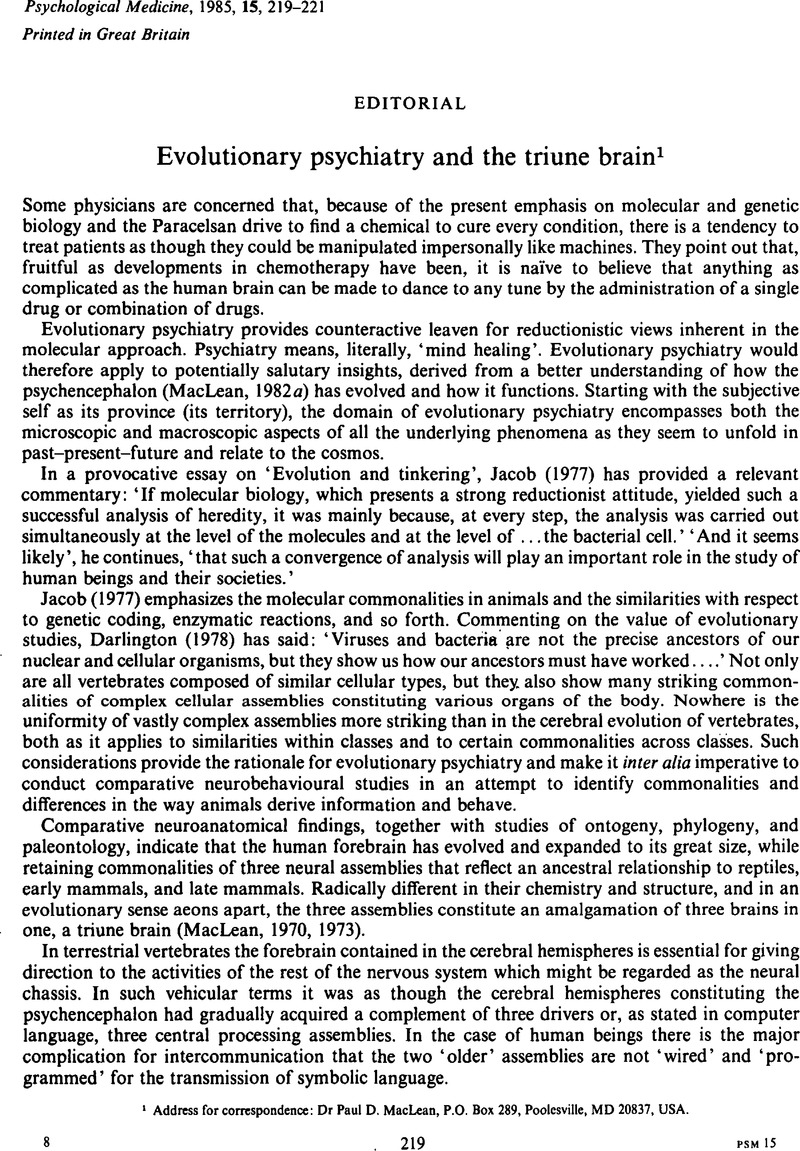Crossref Citations
This article has been cited by the following publications. This list is generated based on data provided by Crossref.
Price, John S.
and
Sloman, Leon
1987.
Depression as yielding behavior: An animal model based on Schjelderup-Ebbe's pecking order.
Ethology and Sociobiology,
Vol. 8,
Issue. ,
p.
85.
1988.
Self-esteem.
The Lancet,
Vol. 332,
Issue. 8617,
p.
943.
McGuire, Michael T.
1988.
On The Possibility of Ethological Explanations of Psychiatric Disorders.
Acta Psychiatrica Scandinavica,
Vol. 77,
Issue. S341,
p.
7.
Ashbrook, James B.
1989.
THE WHOLE BRAIN AS THE BASIS OR THE ANALOGICAL EXPRESSION OF GOD.
Zygon®,
Vol. 24,
Issue. 1,
p.
65.
Ashbrook, James B.
1989.
THE HUMAN BRAIN AND HUMAN DESTINY: A PATTERN FOR OLD BRAIN EMPATHY WITH THE EMERGENCE OF MIND.
Zygon®,
Vol. 24,
Issue. 3,
p.
335.
David, Anthony S.
1989.
The Split-Brain Syndrome.
British Journal of Psychiatry,
Vol. 154,
Issue. 3,
p.
422.
Kreutzer, Natalie Jones
1991.
The Limbic System and Its Role in Affective Response to Music.
Update: Applications of Research in Music Education,
Vol. 10,
Issue. 1,
p.
19.
Kyomen, Helen H.
Nobel, Kenneth W.
and
Wei, Jeanne Y.
1991.
The Use of Estrogen to Decrease Aggressive Physical Behavior in Elderly Men with Dementia.
Journal of the American Geriatrics Society,
Vol. 39,
Issue. 11,
p.
1110.
Price, J. S.
1992.
The agonic and hedonic modes: Definition, usage, and the promotion of mental health.
World Futures,
Vol. 35,
Issue. 1-3,
p.
87.
Schelde, Tyge
1994.
Ethological research in psychiatry.
Ethology and Sociobiology,
Vol. 15,
Issue. 5-6,
p.
349.
Lieberman, Philip
1994.
Human language and human uniqueness.
Language & Communication,
Vol. 14,
Issue. 1,
p.
87.
Lieberman, Philip
1995.
Current Topics in Primate Vocal Communication.
p.
273.
Ashbrook, James B.
1996.
TOWARD A NEW CREATION OF BEING.
Zygon®,
Vol. 31,
Issue. 3,
p.
385.
Corrigan, F.M.
1997.
Parapsychotic grief, theory of mind and the concept of the soul.
Medical Hypotheses,
Vol. 49,
Issue. 4,
p.
301.
Shean, Glenn
2001.
A Critical Look at the Assumptions of Cognitive Therapy.
Psychiatry: Interpersonal and Biological Processes,
Vol. 64,
Issue. 2,
p.
158.
Rohde, Peter
2001.
The relevance of hierarchies, territories, defeat for depression in humans: hypotheses and clinical predictions.
Journal of Affective Disorders,
Vol. 65,
Issue. 3,
p.
221.
Schore, Allan N
2002.
Dysregulation of the Right Brain: A Fundamental Mechanism of Traumatic Attachment and the Psychopathogenesis of Posttraumatic Stress Disorder.
Australian & New Zealand Journal of Psychiatry,
Vol. 36,
Issue. 1,
p.
9.
Greer, Joy M.
and
Capecchi, Mario R.
2002.
Hoxb8 Is Required for Normal Grooming Behavior in Mice.
Neuron,
Vol. 33,
Issue. 1,
p.
23.
Lambert, Kelly G.
2003.
The life and career of Paul MacLean.
Physiology & Behavior,
Vol. 79,
Issue. 3,
p.
343.
Harris, James C.
2003.
Social neuroscience, empathy, brain integration, and neurodevelopmental disorders.
Physiology & Behavior,
Vol. 79,
Issue. 3,
p.
525.





